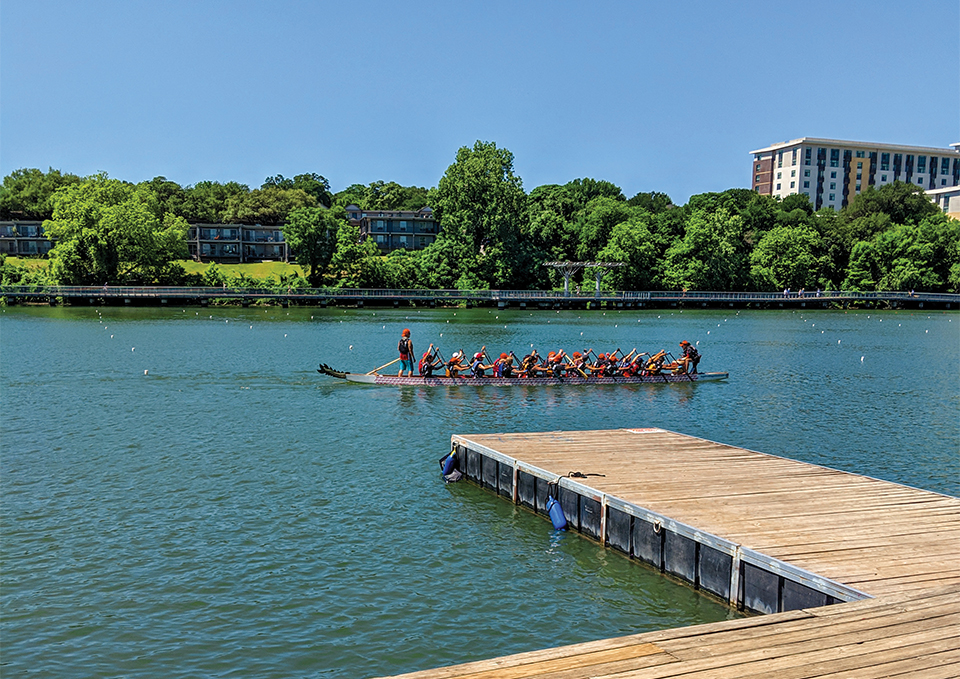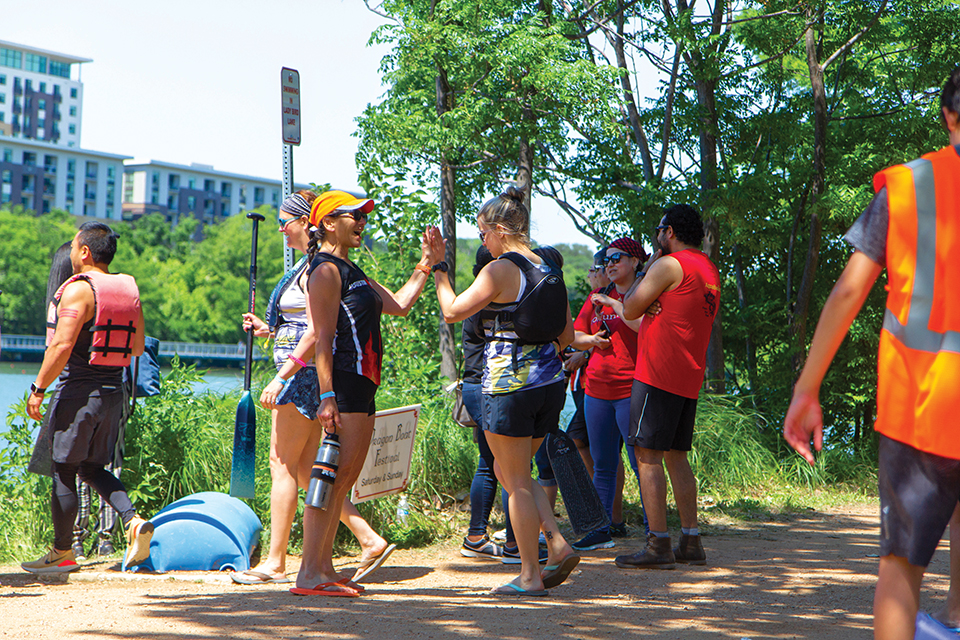Dragon Boating Comes to Austin

Raising a red jar of paint into the air, Amy Wong Mok addresses the crowd gathered around the dock by Lady Bird Lake.
“Is everybody ready?” she says before a long brush is dipped into the container. The brush paints an iris onto the carved head of a dragon, which is attached to a boat floating close to the shore.
This eye-dotting ceremony typically precedes dragon boat racing, an international sport where participants must paddle in sync to race a 40-foot, canoe-style boat. On this particular Saturday, Wong Mock was kicking off the Austin Dragon Boat and Paddle Festival.
Dragon boating originated more than 2,000 years ago in China and is intertwined with the story of a beloved Chinese scholar and minister named Qu Yuan from the fourth century B.C.
In the legend, Yuan commits suicide — throwing himself into a river — in protest of the era’s corruption. People gather in boats, beating drums and splashing the water with paddles to scare away the fish and evil spirits around his body.
Enter dragon boating, a sport based upon the unity of the paddlers who worked together to honor him. That’s according to Wong Mok, who says the story is about a sense of community — reflected not only in people coming together for the sport, but for this festival.
“That is what we are trying to do here — to build a community,” she says.
Wong Mok brought the festival to Austin 21 years ago and has watched it slowly grow into the cultural celebration it is now. Hundreds of people gathered this year to watch teams race on the sparkling lake, enjoy dance and drum performances and compete themselves.

The festival, which was held on April 27 and 28 (the festival is always held during the last weekend in April), includes both competitive and recreational racing teams. Watching the more experienced teams race across the water, it’s clear that the sport requires technique beyond just paddling a boat.
Each dragon boat consists of 20 paddlers sitting side by side, a drummer at the front and a steerer in the back. With each drum beat, the team members paddle in unison — pushing the boat smoothly through the water.
“Getting 20 people to move at the exact same time is hard. It’s a challenge,” Sheena Chang, an organizer of the festival, says. “But once you do, it’s actually really pretty to watch.”
Chang coaches the Austin Coolers, the city’s only year-round competitive dragon boat racing team. She says the team practices up to three times a week, working on this technique.
There are about 40 members on the Austin team, including Scott Baltisberger, the Cooler’s team captain.
He says to move successfully, the team must think with one mind.
“You can’t really have standout stars in the dragon boat. You can’t really have egos,” Baltisberger says. “In this, every single person counts.”
Baltisberger joined the team four years ago and says he was surprised to learn how popular competitive dragon boating was.
“It turns out it’s this huge [sport] — I mean, it’s like all over the world,” Baltisberger says.
The Coolers have traveled to compete in cities around the globe, from Denver to Montreal to Hong Kong. Baltisberger says for him, these trips are one of the best parts of being on the team.
“Wherever you go in the world and you meet people that are involved in the sport, you’re automatically connected,” Baltisberger says. “It’s sort of like a universal language. It’s really enriching.”
At the Austin festival, the Coolers were given a chance to race in their own backyard. The call to compete was answered by teams from Houston, Dallas and even a team from Tempe, Arizona — the Gila Dragons.
Peter Funnel, the team’s coach, says they travel to a couple of destinations a year, but this was their first time coming to Austin.
“The fun part for us is to choose a city that is interesting and not one that we’ve been to all the time,” Funnel says. “We don’t just focus on paddling and just sitting at the event. We’re actually going to take in the sights and sounds of the city.”
On this trip, The Gila Dragons did just that — taking a bicycle tour around Austin before making their way to the festival.
Funnel says dragon boating is unique because it relies on skill and coordination, rather than just athletic ability. He says this gives the Gilas — which has college-aged members as well as members in their 60s and 70s — as good a chance at success as a boat full of younger racers.
“We’ve got quite the age range,” Funnel says. “And what’s really nice about dragon boating is you can still go out and compete against teams even though you might not be 20-something. We still try and bring it.”
This aspect of the sport is emphasized by Chang as well. She says with dragon boating, no matter who you are, “if you’re willing to put in the work, you can get good at it.”

Alongside competitive teams like the Coolers and Gilas, the festival hosted a number of corporate and recreational teams. Some recreational teams, such as the Travis County Sheriff’s Office, return to compete every year, Chang says.
“It’s just a good way to bring people together,” she says. “While they may not necessarily have the time to dedicate to a whole year of training, this is a month out of their year that they can do this — come out on the water and race.”
Many seconds separated the competitive teams’ times from the non-competitive. However, on the shore, it was harder to tell the teams apart.
Different teams mixed together — standing around chatting, sitting in the white chairs in front of the performance stage and gathering at the edge of the water to watch the boats go by.
Perhaps that is what Wong Mok envisioned when she decided to bring the first dragon boat festival to Austin all those years ago. It is certainly something she is proud of now.
“Even if you come to the dragon boat festival alone, look at all the people around you,” Wong Mok says. “You can easily feel the community in Austin.”






